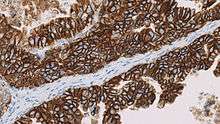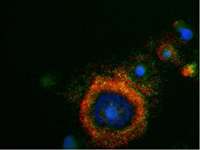Biomarker (cell)
A biomarker, or biological marker, is defined as a "cellular, biochemical or molecular alteration in cells, tissues or fluids that can be measured and evaluated to indicate normal biological processes, pathogenic processes, or pharmacological responses to a therapeutic intervention."[1] Biomarkers characterize disease progression starting from the earliest natural history of the disease. Biomarkers assess disease susceptibility and severity, which allows one to predict outcomes, determine interventions and evaluate therapeutic responses. From a forensics and epidemiologic perspective, biomarkers offer unique insight about the relationships between environmental risk factors.[1]
Classes of Biomarkers
Three broad classes of biomarkers are prognostic biomarkers, predictive biomarkers and pharmacodynamic biomarkers.
Prognostic Biomarkers
Prognostic biomarkers give intervention-independent information on disease status through screening, diagnosis and disease monitoring. Prognostic biomarkers can signify individuals in the latent period of a disease's natural history, allowing optimal therapy and prevention until the disease's termination. Prognostic biomarkers give information on disease status by measuring the internal precursors that increase or decrease the likelihood of attaining a disease. For example, blood pressure and cholesterol are biomarkers for CVD.[1] Prognostic biomarkers can be direct or indirect to the causal pathway of a disease. If a prognostic biomarker is a direct step in the causal pathway, it is one of the factors or products of the disease. A prognostic biomarker could be indirectly associated with a disease if it is related to a change caused by the exposure, or related to an unknown factor connected with the exposure or disease.[2]
Predictive Biomarkers
Predictive biomarkers measure the effect of a drug and tell if the drug is having its expected activity, but do not offer any direct information on the disease.[2] Predictive biomarkers are highly sensitive and specific; therefore they increase diagnostic validity of a drug or toxin's site-specific effect by eliminating recall bias and subjectivity from those exposed. For example, when an individual is exposed to a drug or toxin, the concentration of that drug or toxin within the body, or the biological effective dose, provides a more accurate prediction for the effect of the drug or toxin compared to an estimation or measurement of the toxin from the origin or external environment.[1]
Pharmacodynamic Biomarkers
Pharmacodynamic (PD) biomarkers can measure the direct interaction between a drug and its receptor. Pharmacodynamic biomarkers reveal drug mechanisms, if the drug has its intended effect on the biology of the disease, ideal biological dosing concentrations, and physiologic response/resistance mechanisms. Pharmacodynamic biomarkers are particularly relevant in drug mechanisms of tumor cells, where pharmacodynamic endpoints for drug interventions can be assessed directly on tumor tissues. For example, protein phosphorylation biomarkers indicate alterations in target protein kinases and activation of downstream signaling molecules.[3]
Clinical Applications for Biomarkers
Biomarkers can be classified on their clinical applications as molecular biomarkers, cellular biomarkers or imaging biomarkers.
Molecular Biomarkers
Four of the main types of molecular biomarkers are genomic biomarkers, transcriptomic biomarkers, proteomic biomarkers and metabolic biomarkers.
Genomic Biomarkers
Genomic biomarkers analyze DNA by identifying irregular sequences in the genome, typically a single nucleotide polymorphism. Genetic biomarkers are particularly significant in cancer because most cancer cell lines carry somatic mutations. Somatic mutations are distinguishable from hereditary mutations because the mutation is not in every cell; just the tumor cells, making them easy targets. An example of this would be a mutation in the RAS oncogene or the tumor suppressor RB1 gene that causes retinoblastoma.[4]
Transcriptomic Biomarkers

Transcriptomic biomarkers analyze all RNA molecules, not solely the exome. Transcriptomic biomarkers reveal the molecular identity and concentration of RNA in a specific cell or population. Clinically, trancriptomic biomarkers detect multi-gene molecular patterns, such as miRNA, which can be analyzed and processed through pattern-based RNA expression analysis to isolate differentiated molecular subtypes.[5] Pattern-based RNA expression analysis provides increased diagnostic and prognostic capability in predicting therapeutic responses for individuals. For example, distinct RNA subtypes in breast cancer patients have different survival rates.[6]
Proteomic Biomarkers
Proteomics permits the quantitative analysis and detection of changes to proteins or protein biomarkers. Protein biomarkers detect a variety of biological changes, such as protein-protein interactions, post-translational modifications and immunological responses. These protein alterations elucidate disease and drug mechanisms, high-risk populations and individual reactions to therapeutic interventions.[7]
Metabolomic Biomarkers
Metabolomic biomarkers are unique biochemical metabolites left behind from specific cellular processes in tissues or biofluids like serum or urine. In general, diseases disrupt metabolic pathways via activation or deactivation, rendering distinctive metabolic biomarkers. An example of a metabolic biomarker is serotonin. When alcohol is consumed, the serotonin pathway is activated, so an increase in serotonin could be a product of alcohol consumption.[8]
Cellular Biomarkers
Cellular biomarkers allow cells to be isolated, sorted, quantified and characterized by their morphology and physiology. Cellular biomarkers are used in both clinical and laboratory settings, and can discriminate between a large sample of cells based on their antigens. An example of a cellular biomarker sorting technique is Fluorescent-activated cell sorting.[9]
Imaging Biomarkers
Imaging biomarkers allow earlier detection of disease compared to molecular biomarkers, and streamline translational research in the drug discovery marketplace. For example, one could determine the percent of receptors a drug targets, shortening the time and money of research during the new drug development stage. Imaging biomarkers also are non-invasive, which is a clinical advantage over molecular biomarkers. Some of the image-based biomarkers are X-Ray, Computed Tomography (CT), Positron Emission Tomography (PET), Single Photo Emission Computed Tomography (SPECT) and Magnetic Resonance Imaging (MRI).[10]
Examples of Biomarkers
- Embryonic: Embryonic biomarkers are very important to fetuses, as each cell's role is decided through the use of biomarkers. Research has been conducted concerning the use of embryonic stem cells (ESCs) in regenerative medicine. This is because certain biomarkers within a cell could be altered (most likely in the tertiary stage of their formation) to change the future role of the cell, thereby creating new ones. One example of an embryonic biomarker is the protein Oct-4.[11]
- Cancer: Biomarkers have an extremely high upside for therapeutic interventions in cancer patients. Most cancer biomarkers consist of proteins or altered segments of DNA, and are expressed in all cells, just at higher rates in cancer cells. There has not yet been one, universal tumor biomarker, but there is a biomarker for every type of cancer. These tumor biomarkers are used to track the health of tumors, but cannot serve as the sole diagnostic for specific cancers. Examples of tumoral markers used to follow up cancer treatment are the Carcinoembryonic Antigen (CEA) for colorectal cancer and the Prostate Specific Antigen (PSA) for prostate cancer.[12] In 2014, Cancer research identified Circulating Tumor Cells (CTCs) and Circulating Tumor DNA (ctDNA) as metastasizing tumor biomarkers with special cellular differentiation and prognostic skills. Innovative technology needs to be harnessed to determine the full capabilities of CTCs and ctDNA, but insight into their roles has potential for new understanding of cancer evolution, invasion and metastasis.[13]
 Multiplex analysis of circulating tumor cells using QuantiGene ViewRNA CTC Platform
Multiplex analysis of circulating tumor cells using QuantiGene ViewRNA CTC Platform
References
- 1 2 3 4 Mayeux, Richard. "Biomarkers: Potential Uses and Limitations". NeuroRX.
- 1 2 Gainor, Justin; Longo, Dan; Chabner, Bruce. "Pharmacodynamic Biomarkers: Falling Short of the Mark?". AACR.
- ↑ Sarker, Debashis; Workman, Paul (2007-01-01). "Pharmacodynamic biomarkers for molecular cancer therapeutics". Advances in Cancer Research. 96: 213–268. doi:10.1016/S0065-230X(06)96008-4. ISSN 0065-230X. PMID 17161682.
- ↑ "Genomic Biomarkers". Biomarkers Journal.
- ↑ "RNA Biomarkers". Biomarkers Journal.
- ↑ Blenkiron, Cherie; Goldstein, Leonard; Thorne, Natalie (2007). "MicroRNA expression profiling of human breast cancer identifies new markers of tumor subtype". Genome Biology.
- ↑ "Proteomic Biomarkers | List of High Impact Articles | PPts | Journals | Videos". www.imedpub.com. Retrieved 2015-11-24.
- ↑ "Metabolomic Biomarkers". Biomarkers Journal.
- ↑ "Cellular biomarkers analysis - ImmuneHealth". ImmuneHealth. Retrieved 2015-11-24.
- ↑ "The Promise of Imaging Biomarkers" (PDF). Thomas Reuters.
- ↑ Nagano, K; Yoshida, Y; Isobe, T (2008). "Cell surface biomarkers of embryonic stem cells". Proteomics. 8: 4025–35. doi:10.1002/pmic.200800073. PMID 18763704.
- ↑ "Tumor Markers". National Cancer Institute. Retrieved 2015-11-24.
- ↑ Haber, Daniel A.; Velculescu, Victor E. (2014-06-01). "Blood-Based Analyses of Cancer: Circulating Tumor Cells and Circulating Tumor DNA". Cancer Discovery. 4 (6): 650–661. doi:10.1158/2159-8290.CD-13-1014. ISSN 2159-8274. PMC 4433544
 . PMID 24801577.
. PMID 24801577.